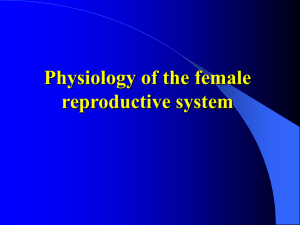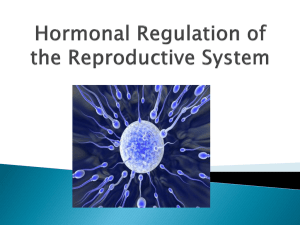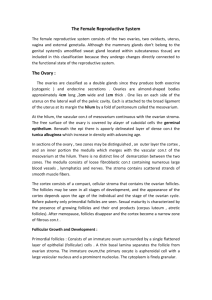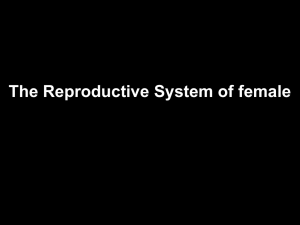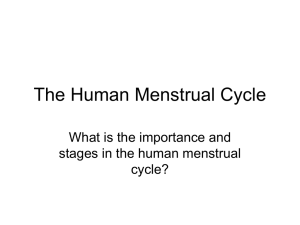female reproductive physiology
advertisement
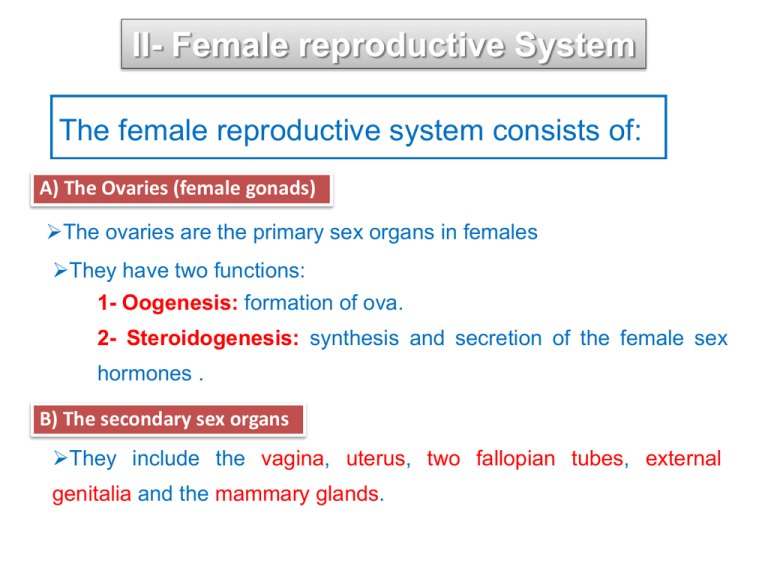
II- Female reproductive System The female reproductive system consists of: A) The Ovaries (female gonads) The ovaries are the primary sex organs in females They have two functions: 1- Oogenesis: formation of ova. 2- Steroidogenesis: synthesis and secretion of the female sex hormones . B) The secondary sex organs They include the vagina, uterus, two fallopian tubes, external genitalia and the mammary glands. Oogenesis In the fetal life: the oogonia divide rapidly by mitosis to form 6-7 millions oogonia (diploid cells). Before birth: the number of oogonia decreases to about 2 millions. Six months after birth: all the oogonia are converted to primary oocytes. At puberty: the two ovaries contains 300.000400.000 primary oocytes. Each oogonium becomes surrounded by a single layer of flat follicular cells to form a primordial follicle. Before ovulation, meiosis (reduction division) occurs. So, the primary oocyte is divided into a secondary oocyte (haploid) and the first polar body which fragments and disappears. After ovulation, the second mitotic division starts and arrests in the metaphase. It is completed only if the mature ovum is fertilized by a sperm. The secondary oocyte is divided into mature ovum and the second polar body. The Female Sexual Cycles The normal reproductive years of the female, from puberty to menopause, are characterized by: Monthly regular changes in the rates of secretion of the female hormones Corresponding physical changes in the ovaries and other sexual organs. There are two female sexual cycles: The ovarian cycle The endometrial (menstrual) cycle The cycles stop only during pregnancy or disease. The duration of the cycle averages 28 days (from 20 to 45 days). The Ovarian Cycle Each ovarian cycle is composed of 3 phases: follicular, ovulatory and luteal phases (1) The Follicular (preovulatory) Phase: At puberty, the two ovaries contain about 400.000 primordial follicles. Each follicle is composed of an ovum (a primary oocyte) surrounded by a single layer of flat granulosa cells. During each cycle, about 20 primordial follicles start to grow in the following sequence: 1) Formation of primary follicles The follicular growth starts by moderate enlargement of the ovum itself. The single layer of follicular cells that cover the Ovum become cuboidal, and divide to form several layers of granulosa cells. These follicles are known as primary follicles . 2) Development of antral and vesicular follicles (secondary follicles) 1- The development starts by rapid proliferation of the granulosa cells giving rise to many more layers of cells. 2- Spindle cells derived form the ovarian stroma collect in several layers outside the granulosa cells giving rise to a second mass of cells called theca. This is divided into two layers: a) The theca interna, a highly vascular layer of epitheloid cells that develop the ability to secrete estrogen and progesterone. b) The theca externa, the outer layer which develops into a less vascular connective tissue capsule surrounding the developing follicle. 3- After few days, the granulosa cells secrete a follicular fluid that contains a high concentration of estrogen. Accumulation of this fluid leads to appearance of the antrum within the mass of the granulosa cells. The follicle is now called antral follicle. 4- Greatly accelerated growth of the antral follicles occurs, leading to larger follicles called vesicular follicles. This accelerated growth is caused by the following: a) Estrogen is secreted into the follicle and causes the granulosa cells to form increasing numbers of FSH receptors. This makes the granulosa cells to be more sensitive to the FSH from the anterior pituitary. B. FSH and the estrogens promote LH receptors on the granulosa cells, thus allowing LH stimulation of the these cells to occur in addition to the FSH stimulation. This leads to more rapid increase in follicular secretion. c) The increasing estrogens form the follicle plus the increasing LH from the anterior pituitary cause proliferation of the theca cells and increase their secretion. 3) Formation of the mature follicle (Graafian follicle) After a week or more of growth, one of the follicles begin to outgrow all the others and the other growing follicles involute and become atretic. The cause of the atresia is unknown, but it has been postulated to be the following: The large amounts of estrogen secreted from the growing follicles act on the hypothalamus to inhibit more increase of FSH secretion from the anterior pituitary preventing further growth of the less developed follicles. The outgrowing follicle continuous to grow because of its high content of estrogen. The mature follicle has the following layers from inside outwards: 1- The ovum (secondary oocyte) surrounded with a thin membrane called zona pellucida. 2- Several layers of granulosa cells surrounding the ovum called Corona radiata. 3- The antrum containing follicular fluid . 4- Several layers of granulosa cells. 5 – Basal lamina. 6- Theca interna . 7 - Theca externa. (2) The ovulatory Phase Definition: Ovulation means release of a haploid secondary oocyte into the peritoneal cavity. Time of ovulation: It occurs 14 days before the onset of the next ovulatory cycle. In a normal 28-day female sexual cycle, ovulation occurs 14 days after the onset of menstruation. Mechanism and hormonal control of ovulation: The theca cells secrete estrogens which reach its peak 48 hours before ovulation. The high blood estrogen level, through its positive feedback effect on the anterior pituitary, increases LH secretion up to 610 folds (LH surge) & FSH secretion is also increased by 2-3 folds. FSH and LH act synergistically to cause rapid swelling of the follicle. The LH causes rapid secretion of follicular steroid hormones that contain progesterone for the first time. Within a few hours, two events occur, both of which are necessary for ovulation : 1. The theca externa begins to release proteolytic enzymes from lysosomes ----> dissolution of the follicular capsular wall ----> weakening of the wall ----> more swelling of the entire follicle and degeneration of a nipple-like protrusion in the center of the follicular capsule called the “stigma”. 2. Simultaneously, there is rapid growth of new vessels into the follicle wall, and at the same time prostaglandins (cause vasodilatation) are secreted into the follicular tissues. These two effects cause plasma transudation into the follicle which leads to more swelling. Finally, the combined follicle swelling and simultaneous degeneration of the stigma cause the follicle to rupture with discharge of the ovum. Diagnosis of ovulation 1- Symptoms - Pelvic pain. - Increased vaginal discharge. - Midcycle vaginal bleeding due to sudden drop of the blood estrogen level after ovulation. 2- Basal body temperature : On the day of ovulation, there is an increase in the basal body temperature by 0.2- 0.5°C due to the thermogenic effect of progesterone secreted by the corpus luteum. The elevated basal temperature remains till the day 26 of the cycle then It drops to the basal level again if no fertilization (pregnancy) occurs. It continues elevated if fertilization (pregnancy) occurs. 3- Examination of cervical mucous: In the preovulatory phase, cervical mucous is characterized by ferning and spinnbarkeit phenomena which disappear if ovulation has occurred. Spinnbarkeit phenomenon: If a drop of cervical mucous is placed between two slides, long threads of mucous will appear between them when they are separated. Ferning phenomenon: If a drop of mucous is spread on a slide and left to dry, the crystals will be arranged in a feather-like shape. 4- Endometrial biopsy: If ovulation occurs, the endometrium will be in the secretory phase (progestational phase). 5- Detection of pregnandiole, the progesterone metabolite, in urine. (3) The Luteal (postovulatory) Phase Formation of the corpus luteum During the first few hours after expulsion of the ovum from the follicle, the remaining granulosa and theca cells enlarge in diameter and become filled with lipid material that give them a yellowish appearance, therefore they are called lutein cells. The total mass of cells is called , corpus luteum. The process of luteinization is mainly dependent on LH. Function of the corpus luteum The lutein cells secrete large amounts of the female sex hormones progesterone and estrogen but more of progesterone. This occurs under the control of LH secreted from the anterior pituitary. Fate of the corpus luteum 1- If fertilization does not occur the corpus luteum is called corpus luteum of menstruation. It continues to function till the day 22 of the cycle, then it begins to degenerate and stops its functions two days before the next cycle. 2- If fertilization occurs, the corpus luteum is called corpus luteum of pregnancy. It continuous to function till the 12th week of gestation, then its function is taken by the placenta. The function of the corpus luteum is maintained during the first 12 weeks of pregnancy by the action of human chorionic gonadotropin (HCG). Anovulatory Cycles Anovulatory cycles are the cycles in which ovulation fails to Occur during the menstrual cycle. These occur in: a) The first 12 -18 months after menarche (the first menstrual cycle) and before the onset of menopause. b) During the use of oral contraceptive pills. c) Some diseases. Anovulatory cycles are characterized by: a) No corpus luteum is formed and therefore, the effects of progesterone on the endometrium are absent. b) Estrogens continue to cause proliferation of the endometriurn which becomes thick enough to break down and begins to slough due to withdrawal of estrogen after degeneration of the Graafian follicle. c) The menstrual cycle is shortened. Contraceptive Pills Oral contraceptive pills usually contain both estrogens and progesterone. They are taken orally by women to prevent pregnancy. Mechanism of action 1- The estrogen content of the pills inhibits FSH secretion, therefore it prevents the growth of ovarian follicles. 2- The progesterone content inhibits LH surge, therefore it prevents ovulation. 3 - The progesterone content increases the viscosity of cervical mucous, therefore it prevents the penetration of spermatozoa. 4- The pills produce endometrial changes making the endometrium unsuitable for implantation of the ovum if it is fertilized. Hormonal changes during female sexual cycle: Functions of FSH: 1- Stimulation of early growth of ovarian follicles. 2- With LH --------> maturation of graafian follicles. 3- Stimulates estrogen secretion by granulosa cells of growing follicles. Functions of LH: 1- Regulates estrogen secretion from theca interna & granulosa cells of graafian follicles. 2- LH surge ------> ovulation & formation of corpus luteum. 3- Stimulates secretion of estrogen & progesterone from corpus luteum. Gonadotropin-releasing hormone (GnRH) -Secreted by hypothalamus into the hypothalamo-hypophyseal portal circulation. -Stimulate secretion of both LH & FSH from anterior pituitary gland. - Secreted in pulses by GnRH pulse generator in the median basal hypothalamus each 1-2 hours which lasts 5-25 minutes. - Pulse frequency is increased by estrogen & decreased by progesterone. - In preovulatory, frequency increases. - At ovulation, the sensitivity of gonadotrops to GnRH increases due to their exposure to high frequency pulses. - In postovulatory, frequency decreases. Estrogens In non-pregnant female, estrogens are secreted mainly by: 1) the ovaries (theca interna of ovarian follicles & lutein cells of corpus luteum), granulosa cells into the follicular fluid, and stromal tissue of the ovary. 2) Minute amounts are secreted by the adrenal cortex. In pregnancy, large quantities are secreted by the placenta. Types: these are 17-β oestradiol, oestrone, and oestriol 1- β oestradiol is the principal one, being 12 times as potent as estrone and 80 times that of estriol. It is secreted by the ovaries. 2- oestrone: a) Small amounts are secreted by the ovaries. b) Most of it is formed in the peripheral tissues from androgens secreted by adrenal cortices and ovarian theca cells. 3- Oestriol: oxidative product of oestradiol & oestrone which occurs in the liver. Functions: 1- On ovaries: a) Stimulate growth of ovarian follicles. b) By inducing LH surge ------> ovulation & corpus luteum formation. 2- On 2ry sex organs: • Uterus: i. Stimulates proliferative phase of menstrual cycle (endometrium). ii. Myometrium: ↑ sensitivity of myometrium to the action of oxytocin, ↑ uterine blood flow, ↑ excitability , ↑ contractile proteins. b) Cervix: they ↑ the amount & ↓ viscosity of cervical mucus which is characerized by ferning & Spinnbarkeit. . c) Vagina: i. Stratification of epithelium which is more resistant to trauma & infection. ii. ↑ vascularity of the wall. iii. Deposition of glycogen -- lactic acid -- acidity of the vagina. d) Fallopian tubes: i. ↑ motility. ii. ↑ number and activity of cilia. which helps transport of the fertilized ovum into the uterus. e) Breasts: i. Deposition of fat at puberty. Ii. Formation of duct system & nipples. iii. ↑ vascularity. Iv. Pigmentation of areola. 3- On female sex characters: a) Feminine distribution of fat in breasts, lower abdomen, buttoks, thigh, mons pubis & labia majora. b) ↑ vascularity of the skin which is soft & smooth. c) ↑ libido & psychological make up of female. 4- Metabolic Effects: a) Protein anabolic effects. b) Proliferation & then union of epiphysis. c) ↓ cholesterol. d) Retention of Na, H2O, Ca, phosphate. 5- On endocrine glands: a) ↑ size of pituitary. b) ↑ secretion of angiotensinogen. c) ↑ thyroxin-binding globulin and transcortin. d) Regulate the secretion of pituitary gonadotropins. Progestins These are steroid female sex hormones C21. They include mainly: 1- Progesterone, which is secreted by: a) Corpus luteum. b) Small amounts by ovarian follicles and suprarenal cortex. c) In pregnancy, considerable amounts are secreted by the placenta. 2- 17 α-hydroxyprogesterone, which is released along with estrogen by the growing Graafian follicles. Functions: 1- On uterus: a) It induces the secretory phase of the menstrual cycle. b) It has antiestrogenic effects which lead to: i. ↓ sensitivity of myometrial cells to oxytocin. ii. ↑ number of estrogen receptors in the endometrium. iii. ↑ rate of conversion of β-estradiol to less active estrogens. c) In pregnancy: i. Is essential for formation of the placenta and embedding of the fertilized ovum. ii. Prevents abortion by inhibiting uterine contractions due to its antiestrogenic effects. iii. It suppresses the ovarian cycles probably by inhibiting the release of pituitary GTHs. 2- On cervix: ↓ amount & ↑ viscosity of its mucus. 3- On vagina: a) Thick mucus. b) Epithelium proliferates and becomes infiltered with leukocytes. 4- Fallopian tubes: ↑ secretion for the nutrition of the fertilized ovum 5- Mammary glands: Prepares them for lactation by promoting growth of secretory alveoli & lobules. 6- Thermogenic effect. 7- Natriuretic effect by antialdosterone effect. 8- Inhibition of ovulation: Menopause Cessation of menstruation due to aging (at 40-50 ys of age). Causes: 1- Burning out of ovarian follicles. 2- Aging of the remaining follicles. Manifestations: (loss of estrogen) 1- Hot flushes. 2- Anxiety and fatigue. 3- Atrophy of ovaries. 4- Atrophy of 2ry sex organs except the clitoris. 5- Osteoporosis & muscle wasting. Treatment: By local & systemic estrogen. Ovarian Dysfunction 1- Hypogonadism: a) Primary due to: -Congenital abnormalities of ovaries. - Surgical removal. - Destruction by diseases, toxins, or x-ray. b) Secondary due to failure of GT secretion. It may be of pituitary or hypothalamic origin. Manifestations: A) Before puberty: 1- 1ry amenorrhea and sterility. 2- 2ry sex organs fail to develop. 3- Loss of sexual desire and homosexuality. 4- Delayed union of epiphyseal cartilages - tall 5- Absence of feminine distribution of fat. 6- ↓ BMR. B) After puberty: 1- 2ry amenorrhea and sterility. 2- Atrophy of endometrium, vaginal mucosa and breasts. 3- Osteoporosis & muscle wasting. 4- Psychological and vasomotor disturbance. 2- Hyperfunction: This is usually due to ovarian tumours. Manifestations: a) Before puberty: precocious puberty. b) After puberty: polymenorrhea & menorrhagia. c) After menopause: Irregular uterine bleeding after stoppage of menstruation Fertilization and Pregnancy After intercourse, about 1000-3000 sperms succeed in traversing the fallopian tube to reach the ovum. Time required is about 5-10 minutes, as transport is facilitated by ↑ contractility of uterus & fallopian tubes by oxytocin & prostaglandins. 1-10 hours are required before penetration, for: a) Washing away inhibitory factors and cholesterol vesicles around the sperm. b) Influx of Ca into the sperm -------> ↑ motility of the flagellum and release of proteolytic enzymes from acrosome as hyaluronidase and acrosin. This is called capacitation of the sperm. Head & body of one sperm penetrate the zona pellucida and corona radiate & tail is left behind. Zona pellucida has lattice-like structure. When punctured, a special substance diffuses throughout lattice forming a barrier against other sperms. Fertilized ovum takes 3-5 days to reach the uterus. It divides to form blastocyst surrounded by an outlayer of syncytiotrophoblast and inner layer of cytotrophoblast. The endometrium ------------------------> decidua Functions of the placenta: 1- Respiratory Functions: a) O2 supply: Maternal PO2 50mmHg and fetal 30mmHg. This low pressure gradient is compensated for by ↑ Hb content of fetal blood. b) Diffusion of CO2 from fetal (~ 48 mmHg) to maternal blood (~ 43 mmHg). 2- Nutritive and metabolic functions: Carbohydrates, proteins, fats and minerals are transported into the fetus. 3- Excretion of fetal waste products. 4- Protective function. 5- Endocrine Functions: It secretes the following hormones: a) Human Chorionic Gonadotropins (HCG): Secretion starts about 8 days after ovulation --------> peak at 10-12 weeks, then ↓ to a minimum at 16-20 weeks and remain constant till end of pregnancy. Functions: i. Maintains the function of corpus luteum till 12th week of pregnancy. ii. Stimulates fetal testes ------> testosterone. iii. Stimulates release of DHEA from fetal adrenal cortex. iv. TSH-like activity. v. Release of relaxin from placenta. b) Progesterone. c) Estrogens. d) Human Chorionic Somatomammotropin (HCS): Release starts at 5th week of pregnancy and progress till the end of pregnancy. Functions of HCS: i. Weak lactogenic effect. ii. Weak anabolic effect. iii. Stimulates lipolysis in the mother. e) Relaxin Hormone: It produces: i. Relaxation of pelvic ligaments. ii. Softening of cervix. iii. Inhibition of uterine contractions. Other hormonal changes during pregnancy: 1- Pituitay gland. 2- Corticosteroids. 3- Thyroid hormones. 4- Parathyroid hormone.

